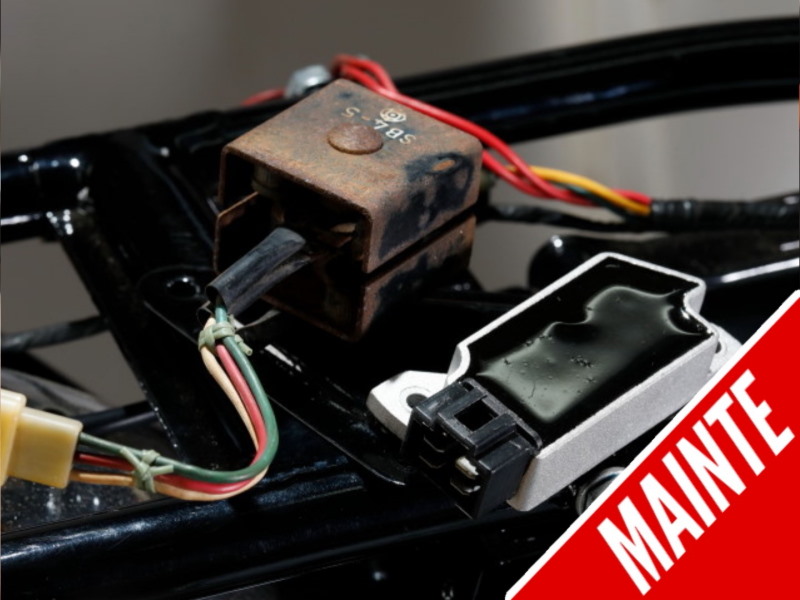The outline of the charging system is that the alternating current generated by the generator is rectified by a rectifier and converted to direct current, and the voltage is regulated by a regulator to charge the battery. For riders who are not good with electricity, this may sound like gibberish at this point, but what if I told you that some discontinued motorcycles did not have regulators? How do you charge a battery without regulating the voltage? You are right to wonder.
Regulator is not necessary depending on the amount of power generated by the generator, but the risk of overcharging the battery is still present

Genuine rectifier regulator for 250cc class Yamaha vehicles. The generator is a three-phase AC type. Three of the four-pin couplers are connected from the generator, and the remaining one is a positive output that is rectified to DC and voltage controlled for battery charging. The negative output is grounded to the case itself.

The 90 cc Yamaha HS1 sold at the end of the 1960s was equipped with a silicon rectifier (diode) lectifier under the seat rail. There was no regulator, and all electricity generated was used to charge the battery.

There are three wires leading to the rectifier. Green and white are the AC input from the generator, and red is the output to charge the battery. The bolt that secures the rectifier to the frame is the ground terminal, and the circuit is formed by the negative lead of the battery that is secured to the frame.
Batteries installed in motorcycles and automobiles are direct current batteries, like the dry cell batteries we are familiar with, with a fixed positive and negative pole. In contrast, the electricity generated by a generator (alternator), which rotates together with the engine, is an alternating current whose positive and negative poles are periodically interchanged like a wave. generators became the mainstay.
Since the generator generates AC, the battery, which is DC, cannot be charged as it is, and rectification is required to convert AC to DC. The rectifier is the part for this purpose. AC is cyclically switched from 0V to positive voltage, positive to 0V, 0V to negative, and negative to 0V over time. By adding a rectifier to this flow, only the positive electricity above 0V can be extracted and converted to DC, and the DC is used to charge the battery.
Used in combination with a rectifier is a voltage regulator that controls the voltage. In the case of an ordinary lead-acid battery, the voltage per unit of battery is roughly 2 V. If three of these cells are connected in series, the voltage is 6 V. If six cells are connected in series, the voltage is 12 V. Three of these cells in series make 6V, and six connected in series make a 12V battery.
Batteries must be recharged because their voltage decreases as they are discharged. However, the battery voltage is fixed at 6V or 12V, and charging at 20V will not result in a battery voltage of 20V. Rather, if the voltage is too high, the battery will be overcharged, which will adversely affect the battery. The regulator controls this.
The rectifier, which rectifies alternating current to direct current, and the regulator, which controls the charging voltage, are like one and the same thing. In the past, each existed as an independent electrical component, but with the spread of semiconductors, they are now integrated as a rectifier-regulator (regulated rectifier).
However, some moped-class discontinued motorcycles are not equipped with a voltage regulator. Since the power generation itself is done by alternating current, they are equipped with a rectifier that rectifies the current to direct current, but the battery itself is used as a regulator to control the voltage. As explained earlier, motorcycle batteries are 6V or 12V, and the battery itself will not go to 9V or 15V even if more voltage is added. So the indicator and brake bulbs that are operated by the battery will not be cut off. In other words, it functions as a regulator.
The idea of a generator system with a regulator is that the generator raises the voltage as much as possible and the excess is cut by the regulator, while a generator system without a regulator prevents overcharging by designing the generator's generating capacity to balance with the battery voltage.
To charge a battery, whether 6V or 12V, a voltage higher than the battery voltage must be applied. Without a regulator, the electricity generated by the generator is used to charge the battery. However, if the generator continues to generate power while the engine is fully open without turning on the turn signals or brakes, the battery will be overcharged, and if the battery is an open type, which is common in batteries for discontinued motorcycles, the electrolyte will volatilize and the battery will malfunction.
Many users of 6V discontinued vehicles have experienced the mysterious phenomenon of light bulbs going off one after another in various parts of the vehicle body while driving. This is the result of a flat battery and loss of voltage control due to continued driving without noticing the volatilization of electrolyte.
- Point 1・Electricity for motorcycles and automobiles is generated in AC, rectified to DC by a rectifier, and the voltage is controlled by a voltage regulator to charge the battery.
- Point 2: Some discontinued motorcycles with small displacement and old motorcycles do not have a regulator because the battery itself controls the voltage.
Simply adding parts for current use to a discontinued motorcycle without a regulator will enable control of the charging voltage.

The rectifier regulator on the right has three AC inputs and one output from the generator, making it a 4-pin regulator, but the input-output relationship is the same as that of the half-century-old rectifier on the left; which pin is used for input and output on a 4-pin rectifier regulator should be confirmed by the wiring color of the vehicle body-side harness or The wiring color of the harness on the vehicle body side and the wiring diagram of the vehicle body are necessary to confirm which pin is used for input and output.

This is a wiring diagram of the Yamaha HS1 rectifier. By combining diodes that allow current to flow in only one direction, only the positive side is extracted from AC that alternates between positive and negative output and converted to DC. In the example shown in the figure, the green and white diodes periodically switch between positive and negative, but the output from the red diode is always positive, allowing the battery to be charged.

The generator in HS1 is a type called single-phase AC with two wires (green and white) coming out of the generator coil, whereas the generator in this wiring diagram (AC Magneto in the diagram) is a three-phase AC type with three wires leading to the rectifier regulator. Three-phase has higher power generation efficiency than single-phase, and the generator can be made smaller when generating the same amount of power.

Prepare a coupler to connect the wiring on the vehicle body side to the rectifier regulator to be diverted and installed. green and white, which match the wiring color of HS1, are the AC input and red is the output.

The rectifier regulator is mounted in the space under the seat rail. During installation, it is important to ensure that the case is grounded to the vehicle body. Here, a special wire was installed to connect directly from the mounting screw to the negative terminal of the battery. With the addition of the regulator function, the battery is now able to cut off the charge and prevent overcharging when the battery is in good condition.
The generators of motorcycles in the days when regulators were not attached were designed so that the charge-discharge balance would be matched with it, but in reality, there are many batteries that dry up due to overcharging. To prevent this from happening, it is certainly a good idea to check the electrolyte level regularly, but it is also true that it is troublesome in the sense of today's motorcycles.
An effective and practical solution is to add a regulator. Specifically, the rectifier equipped on discontinued vehicles is replaced with a rectifier regulator that is installed on today's motorcycles. The regulator will cut off any voltage that would cause the battery to overcharge, thus freeing it from the worry of overcharging.
The concept is simple, but there are a few caveats. First of all, 6V vehicles require a 6V rectifier regulator, while 12V vehicles require a 12V rectifier regulator. 6V rectifier regulators can be found at online stores that sell parts for the 4 Mini system.
For 12V vehicles, the parts required depend on the lighting system circuit on the body side. The most popular 12V rectifier regulator for moped class vehicles is a compatible part for models that use AC for headlights and taillights, such as the Honda Monkey of the carburetor era.
In those models, the AC generated by the regulator to charge the battery is rectified and voltage controlled by a rectifier-regulator, while the AC generated for the headlight and tail lamp is used as AC, with only voltage controlled. This method of power generation is also common in 6V mopeds.
And some discontinued models that are 12V and not equipped with regulators, such as the 1960s Yamaha 90cc shown here, charge the battery with all the electricity they generate, just like mid-size motorcycles and larger, and also use the battery to power the headlight and taillight. Although few of these bikes have survived and are in the overwhelming minority, updating the electrical system is effective.
For discontinued vehicles that use all the electricity generated for recharging, a rectifier regulator for mid-size vehicless or larger can be diverted, instead of one for AC headlight motorcycles such as the Monkey series. Generators for mid-size motorcycles and above are mostly three-phase AC types, and the configuration of the generator coil is different from that of the moped class, but the parts themselves can be used.
Even though they are silicon rectifiers using semiconductors, motorcycle rectifiers from more than half a century ago are large and rugged in size. In comparison, current components that integrate rectifiers and regulators are compact and battery-friendly.
For riders who are not good with electricity, it is difficult to understand it only through classroom learning.
Knowing that there are problems and complaints, such as batteries drying up due to overcharging, and that this is caused by the lack of a regulator, and thinking about how to deal with this problem may gradually eliminate their dislike of the electrical system.
- Point - Replacing discontinued rectifier with a rectifier regulator for current vehicles will allow control of battery charge voltage.



